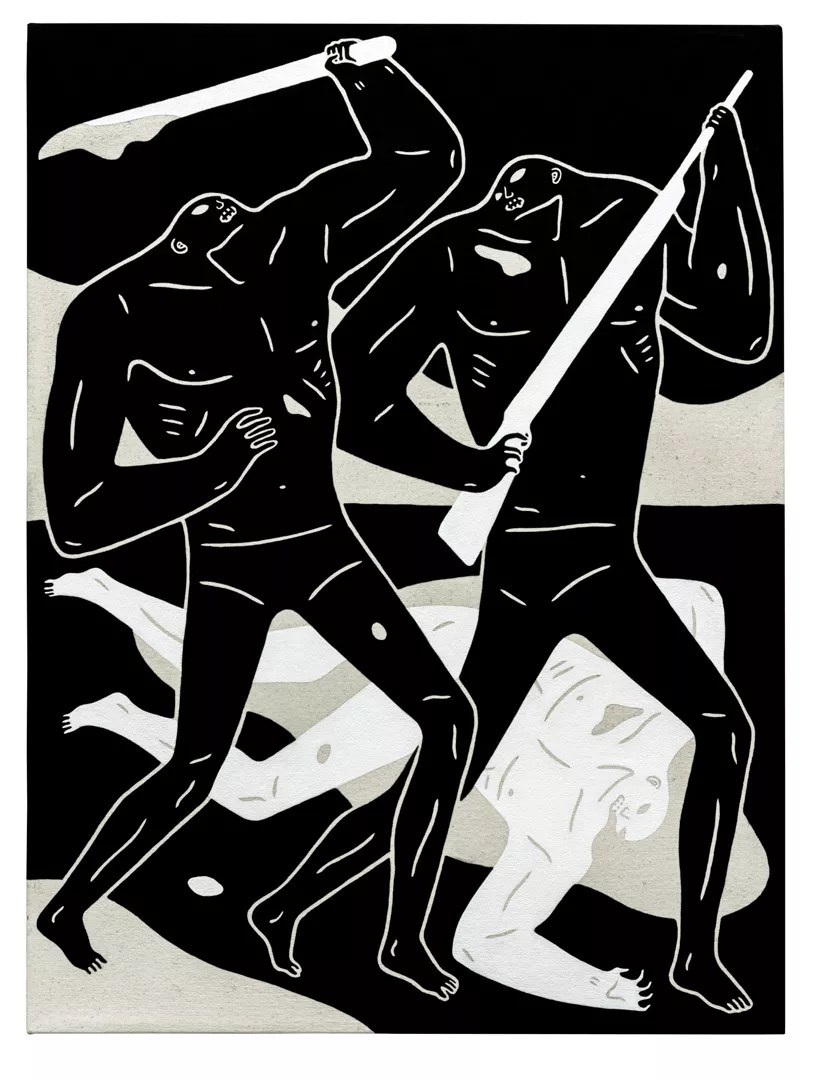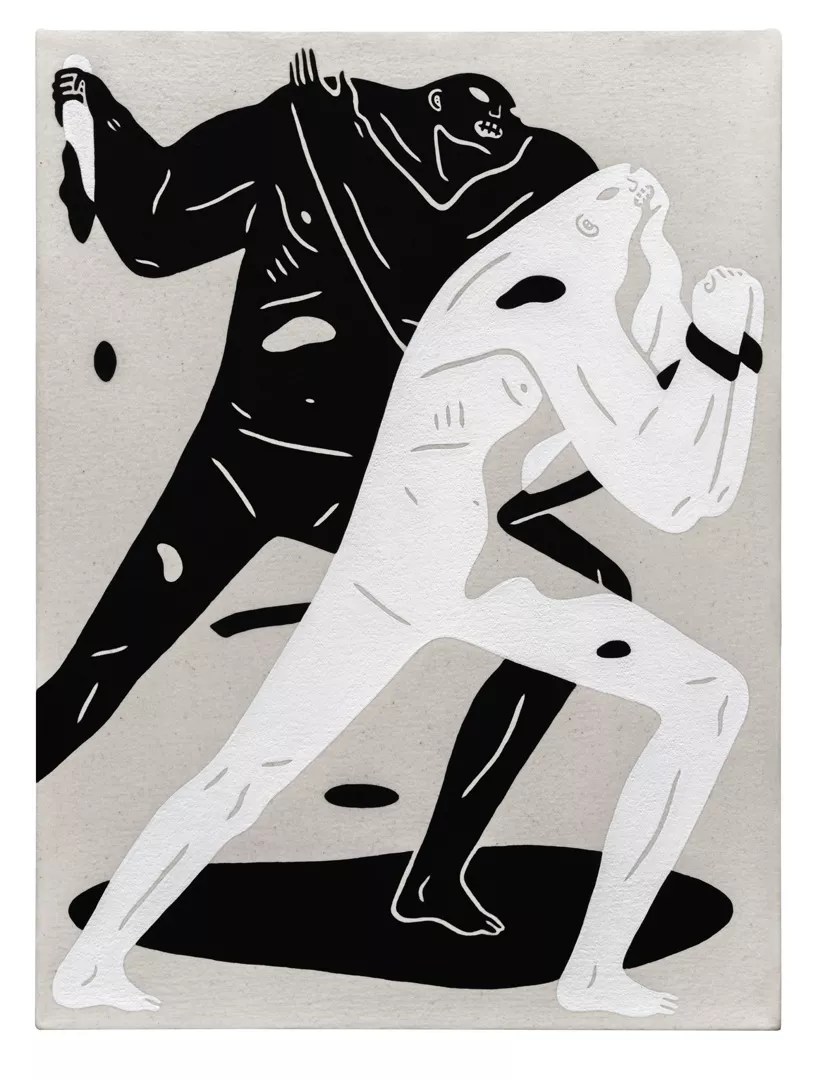
Courtesy of Cleon Peterson and Over the Influence, Hong Kong

Audio By Carbonatix
When MCA Denver promises big, it goes BIG: Anyone driving in the vicinity of the lower downtown Denver museum can’t possibly have missed the gigantic art currently wrapping itself around the outside of the building. The work belongs to L.A.-based artist Cleon Peterson, who’s also created a monumentally striking artwork environment inside the MCA for the exhibit Cleon Peterson: Shadow of Men, which opened February 8 for a long run through May. Outwardly composed of stylish graphics and a large scale, Peterson’s works reveal darker stories, something he’ll discuss on stage with his friend and mentor Shepard Fairey on March 12 at the Newman Center for the Performing Arts. To help you prep for the live interview, we caught up with the MCA’s Adam Lerner, who curated Shadow of Men, and Peterson, as he was installing his work, for useful insights into the nature of the show and the artist’s work. Cleon Peterson, Courtesy of Cleon Peterson and Over the Influence, Hong Kong
Westword: How’s the installation going?
Cleon Peterson: It’s going great. I finished the exterior, and for the last three days I’ve been painting murals inside the hallway. I’m just finishing that today, and then I’ll be hanging paintings.
Denver, make your New Year’s Resolution Count!
We’re $12,000 away from reaching our $50,000 year-end fundraising goal. Your support could be what pushes us over the top. If our work has kept you informed and connected this year, please consider making a contribution today.
Adam Lerner: I’d be lying if I didn’t admit that part of me was not a little terrified. But I’m accustomed to that.
Westword: How has it been working with Adam Lerner?
Peterson: He’s got a really good vision for the museum. I think he’s doing new things, and it’s great to work with someone who’s always taking risks.

Cleon Peterson,
Courtesy of Cleon Peterson and Over the Influence, Hong Kong
Westword: Adam, what’s Cleon Peterson’s story, and how does it relate to the work?
Lerner: I have never worked with an artist whose personal story and his personal traumas are so visibly expressed and so clearly expressed in his art.
He has violence in his personal background – I guess his mother was a sex worker, so he had an unstable family situation. He was already making violent work as a kid. Then his mom saw that he could draw well, so she had him making impressionist-style paintings in Seattle. But it was not his own style, and he couldn’t take the pressure anymore – he associated that art with his mother.
So he left and became a skateboard kid, then he became addicted to drugs and ended up in jail, and then in mental institutions.
He got clean, took a job at Fairey’s studio, and Fairey got him going. He learned that he could make money through graphic design. Then, in grad school, he was exposed to philosophers who affirmed his ideas about otherness and social deviance. He saw his story come clear. In 2006, he began to make art that was violent. It was a return to do what he did as a child.
It’s extraordinary – it’s almost a textbook case study of Freud’s idea that in mainstream culture, violence is sublimated. In fact, late in life, around time of the Nazis, Freud began to focus less on sexual repression and more on how we repress violence, how that repression of violence is an equally unhealthy task to transform into culture and society.
That’s exactly what Cleon has done – by letting his own inner violence out, he’s able to find peace.

Cleon Peterson,
Courtesy of Cleon Peterson and Over the Influence, Hong Kong
Westword: How did you find your aesthetic – the contemporized classical imagery, the two-color line compositions of figures engaging in acts of violence, sometimes on a monumental scale?
Peterson: I was always influenced by historic art. My other influence is design. I was a designer, and I worked with a limited palette, pared down to essential shapes, to create this kind of direct feeling and power and strength, using as few lines as possible.
Lerner: His work has amazing duality. On one hand, it’s got this incredible, cool, graphic, decorative quality; it’s like wallpaper. But that contrasts with the intensity of his violent subject matter. So it’s disturbing to look at, because you find pleasure in its incredible balance of beauty and composition, yet you’re disturbed when you connect with the subject matter.
It’s the next generation of this kind of graphics-inspired street-art kind of aesthetic begun a generation earlier by Shepard Fairey.
Westword: Talk about your friendship with Shepard Fairey. How has he influenced you?
Peterson: We have the same kind of work ethic. It’s great to have a friend who you can say twenty years have gone by, and we’ve been working hard all these years and still continue to be friends. We’ve known each other since 1998. Even before that, I knew of him. We grew up in the same circles. It’s cool that we’re doing this thing together.
We’ve never been paired together to talk publicly before, but we used to sit next to each other for a decade. It’s going to be interesting for me, and hopefully for everybody.

Cleon Peterson,
Courtesy of Cleon Peterson and Over the Influence, Hong Kong
WW: Back to the exhibit, what about the presentation, with art wrapped around the museum inside and out? How does this exhibit compare in scale to past projects?
Peterson: The exterior is the largest thing I’ve ever covered. It covers half of the building. I’d love to make something monumentally larger than life, to create the work so large that it feels like you’re small within the environment of the work.
Doing work in the city on the exterior of a building, you’re dealing with a whole different scale than inside. If people drive past in a car, it has to be large in order for them to be able to see it. But it also has to fit within the rest of the city.
Inside, this is a beautiful, white, clean space. I made large-scale paintings where it feels like you’re walking into a painting that’s surrounding you on all sides to create a feeling. These paintings for the large room are the biggest paintings I’ve ever made.
Lerner: This is the first time he’s had a solo museum exhibition. I decided to push him to create an environment with massive wall murals and paintings. You’re not just looking at paintings. You don’t have that freedom. It’s like you’re inside his paintings – you’re enveloped in his walls of floor-to-ceiling images.

Cleon Pterson, “Backstabber.”
Courtesy of Cleon Peterson and Over the Influence, Hong Kong
Westword: What’s your message? What do you hope people talk about after viewing your work?
Peterson: I’m trying to confront with underlaying balance the parts of society that tend to be ignored. With all the wars we’re in and the political fearmongering – everything going on in the world now and for the last fifteen years – there’s now a general apathy toward actually owning what’s going on. We all have a part to play in it. What’s going on in Afghanistan – we don’t experience those things here.
And there’s another side of that, too. I want people to understand that everyone has a dark side within them – by knowing that and not trying to push it down, people can in some way create an empathy. Instead of thinking it’s someone else’s problem, it’s important to confront and take ownership.
Lerner: Shepard has a message. But I think Cleon doesn’t have one. He HAS to make this; he has to express this element of himself. The message we take from it is this: We ought to look at our own shadow. We cannot pretend that our true self is a civilized peaceful self and everything else is an error. We are all made up of very bad things we do to each other.
Spend an evening with Cleon Peterson and Shepard Fairey on Monday, February 12, from 7 to 8:30 p.m. in Gates Concert Hall at the Newman Center for the Performing Arts, 2344 East Iliff Avenue on the University of Denver campus. Learn more and find the link for tickets, $8 to $17, on the MCA Denver website, or go directly to the Newman Center site. The exhibit Cleon Peterson: Shadow of Men runs through May 27 at MCA Denver, 1485 Delgany Street.